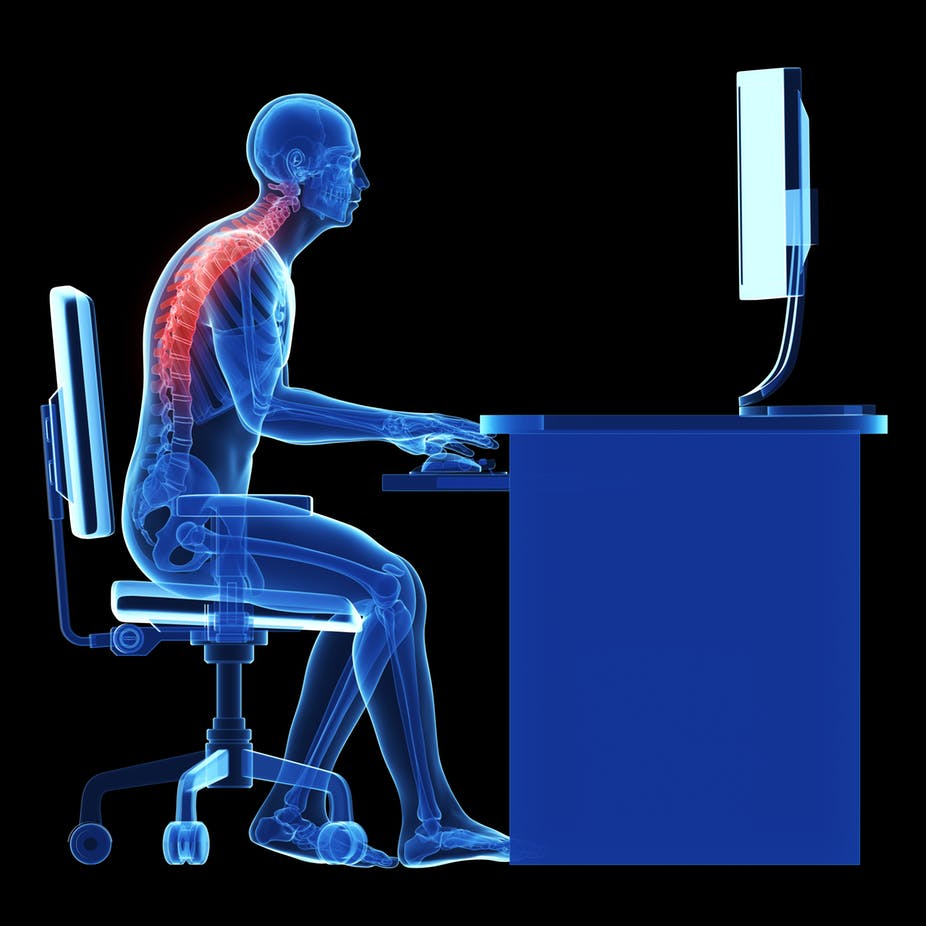

Activate Health & Fitness
“massage can be a powerful tool to help you take charge of your health and wellbeing”
ARE YOU FEELING FAMILIAR ACHES AND PAINS AGAIN NOW THAT YOU’RE BACK AT WORK?
WHY AM I GETTING PAIN?
BAD POSTURE
Having correct posture while working at a desk, on your feet, or lifting and moving things will decrease the risk of getting spinal pain – how you hold your body in correct anatomical position is instrumental in determining how you feel at the end of the day. Obviously?
Like when putting a piece of furniture together – it's important to make sure everything is lined up properly, so everything is level and balanced. That way it won’t be unsteady, and it can provide maximum support for you.
The same goes for our bodies. We need to make sure our hips, spine, shoulders, and neck are level, balanced and in proper alignment. This helps our brain and our bodies function optimally. On top of this, you also need our work station set up in the correct way. If you sit at a desk your chair needs to be adjusted to the right height so your feet are flat on the floor, and your forearms can rest on the edge of the desk.
SITTING FOR EXTENDED PERIODS
Do you catch the train to work? The bus? Or do you drive? All of these things have something in common –you are sitting down. And then when you get to work, it’s quite possible that you will sit down for 7, 8 or even 9 hours. Sometimes this is unavoidable in your profession. But most of the time we are able to get up and move around throughout the day - we just don’t.
Being in a static position for extended periods of time can create pressure on the neck and lower back and is often the cause of pain. Sitting at a desk with incorrect posture can also cause internal rotation of the shoulders (also known as rounded shoulders), and it puts a lot of strain through the thoracic, or mid-back region. People who cross their legs under their desk can also cause an imbalance through the hips, as usually they are in the habit of always crossing their legs to a certain side.
NOT GETTING ENOUGH EXERCISE
The endorphins that are released during exercise play an important part in our mood, with serotonin boosting your mood and overall sense of well-being. Not only does your brain love it, but your body does too. Our bodies were built to move. Yes - sometimes if we overdo it, we can end up feeling a bit sore after a workout. But more often than not, moving will help your body feel better, and iron out those aches and niggles that come from our long days at work.
.
STRESS
Everyone processes stress differently. No matter if it is internalised or verbalised, or whether it comes from workload, environment, relationships or personal life. Stress can take up a large amount of space in our brain, but it can also manifest itself physically. If not dealt with properly (and again that process is different for everyone), the physical implications can be seen in the way of problems sleeping, headaches, migraines, neck pain, shoulder pain, stiffness through the upper back, and clenching and tightness of the jaw.
HOW CAN MASSAGE HELP?
Pros
Conclusion:
Cast aside any thoughts that massage is only a way to indulge or pamper yourself. On the contrary, massage can be a powerful tool to help you take charge of your health and well-being, whether you have a specific health condition, a soft tissue injury or are looking for a way to combat stress. Returning to work after a significant period of ‘downtime’ over the Christmas break can cause niggles, pains, poor posture or stress to resurface. Now is the time to get on top of your health, improve your day to day quality of life, manage your stress, and reduce muscle tension by building regular massages into your lifestyle.
Research References:
6 Things to know about massage therapy for health purposes. (2014). Retrieved March 07, 2016, from https://nccih.nih.gov/health/tips/massage.
Adams, R.; White, B.; Beckett, C. (2010). The effects of massage therapy on pain management in the acute care setting. International Journal of Therapeutic Massage and Bodywork. 3(1). Retrieved on March 7, 2016 from http://www.ncbi.nlm.nih.gov/pmc/articles/PMC3091428/pdf/ijtmb-3-1-4.pdf.
Kargarfard, M., Lam, E. T., Shariat, A., Shaw, I., Shaw, B. S., & Tamrin, S. B. (2015). Efficacy of massage on muscle soreness, perceived recovery, physiological restoration and physical performance in male bodybuilders. Journal of Sports Sciences, 34(10), 959-965. Retrieved March 07, 2016 from http://www.ncbi.nlm.nih.gov/pubmed/26334128.
Massage therapy for health purposes: What you need to know. National Center for Complementary and Integrative Health. https://nccih.nih.gov/health/massage/massageintroduction.htm. Accessed Nov. 4, 2015.
Moyer CA. Affective massage therapy. Int J Ther Massage Bodywork. 2008;1(2):3–5. PubMed #21589715. ❐ PainSci #54758. ❐
Shulman KR, Jones GE. The effectiveness of massage therapy intervention on reducing anxiety in the work place. Journal of Applied Behavioral Science. 1996;32:160–173

Activate Health & Fitness

